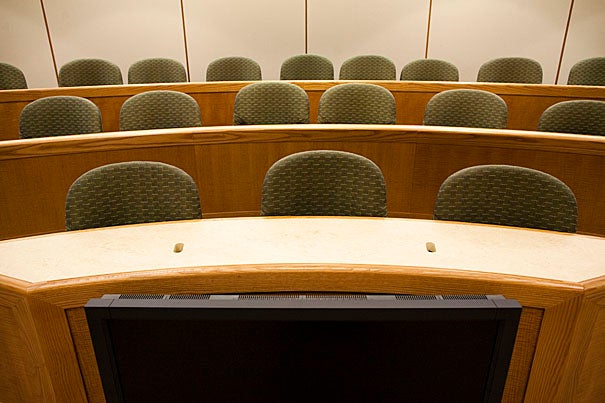
Two of the new classrooms at Larsen Hall have tiered seating, giving every student optimal sight lines. Desk surfaces are Marmoleum, made from 100 percent natural ingredients and installed without adhesives.
Stephanie Mitchell/Harvard Staff Photographer
Class act
Harvard classrooms win highest green rating
Call it a class act.
Three renovated classrooms in Larsen Hall have received the highest sustainability rating there is — Platinum — from the U.S. Green Building Council.
The rating, awarded earlier this month (July), makes these Harvard Graduate School of Education (HGSE) classrooms the first LEED-CI Platinum classrooms in the world.
After six months of design work and planning, the renovations were started last summer and completed in October. What was once a two-floor warren of small offices is now space for three classrooms that are muted and serene.
“A lot of planning went into this,” said Jason Carlson, director of operations at HGSE, who also directs the School’s 15-member volunteer Green Team.
LEED stands for Leadership in Energy and Environmental Design, a certification system for green buildings used in more than 30 countries. The Platinum rating is the highest, and the hardest to attain.
In the case of the Larsen renovations, “CI” stands for “commercial interior,” a rating system that focuses on interior improvements of new or existing space. Other LEED ratings are for new buildings.
The Platinum LEED certification required a complete makeover of lighting, electrical, heating, cooling, and ventilation systems on Larsen’s first and second floors — all with an eye to reducing energy use, water use, and construction waste.
The materials used were vetted according to recycled content, origin, and environmental health considerations. About 80 percent of the wood for trim and desks, for instance, is ash from forests that are certified to be sustainable.
Of all the materials used, 25 percent (by cost) came from no more than 500 miles away, reducing the energy needed to transport them. Another 23 percent — including furniture, carpet, and acoustic surfaces — contain recycled content. In the hallways, all surfaces are made of PaperStone, the 100-percent recycled product called the “countertop with a conscience.”
All paints and adhesives in the classroom spaces are “low VOC” — that is, low in the volatile organic compounds associated with degraded indoor air quality.
And all three rooms — with capacity for 50, 60, and 80 students — are fitted with occupancy and CO2 sensors that adjust heating, cooling, lighting, and ventilation. Reduced wattage requirements for lighting alone means the Larsen space is 28 percent more efficient than code.
Energy efficiency measures at Larsen will reduce the greenhouse gas footprint of the building by an estimated 5 percent.
All these steps “really breathed new life into this building,” said Carlson. He called the Platinum designation “a tremendous honor and a result of the collaborative effort of the entire project team.”
Working with Carlson on the Larsen project was Andrea Ruedy Trimble, manager of green building services for Harvard’s Office for Sustainability (OFS).
“The Larsen project set very ambitious sustainability goals around lighting efficiency and quality,” said OFS assistant director Nathan Gauthier. “This project is a model for lighting design in a classroom building and will be influential in the design of all future classrooms.”
The Larsen classroom renovation project required tearing the first two floors of Larsen right back to the walls.
The new ground-floor classroom has 80 seats in tiered rows. Shades move up and down to harvest daylight. On the next floor up is one classroom of 50 tiered seats, and another classroom —“breakout space” — that can accommodate up to 60 students in six groups.
“The faculty are thrilled,” said Carlson, who is also a veteran of LEED renovations at Harvard Business School. “This is a much-needed space on campus. It enhances the learning experience.”
The LEED-certified classrooms are also a learning experience for facilities managers at Harvard, he added, where cross-School lessons in sustainability are already “iterative and constant.”
Meanwhile, said Carlson, the new classroom spaces “support the learning experience of future educators, researchers, and policymakers.”
Larsen Hall, a handsome red brick building constructed in 1965, is used for classrooms, offices, and research space. It was named after education reformer Roy E. Larsen ’21, a founder and chairman of Time magazine and other publications.
— Includes reporting by the Harvard Graduate School of Education




